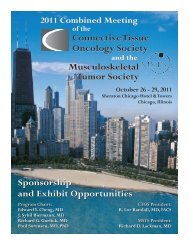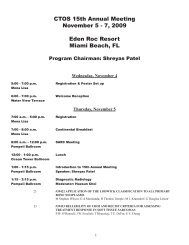207 Poster Session 2 - Connective Tissue Oncology Society
207 Poster Session 2 - Connective Tissue Oncology Society
207 Poster Session 2 - Connective Tissue Oncology Society
You also want an ePaper? Increase the reach of your titles
YUMPU automatically turns print PDFs into web optimized ePapers that Google loves.
Scientific <strong>Poster</strong>s – <strong>Poster</strong> <strong>Session</strong> 2determine patient classification accuracy, similar to whatwould be used for a clinical diagnosis.Conclusion: Proteomic differences were observed betweenspectra from sarcomas that did and did not metastasizewithin 2 years of diagnosis. A Genetic Algorithm classificationmodel consisting of 15 peaks could successfullydetermine future metastasis of the tumors. Tryptic digestionof fresh frozen and formalin-fixed, paraffin embeddedtissue sections result in similar appearing spectra. Theseresults have been used to develop classification models todifferentiate HMP from LMP in both frozen and FFPE tissueand evaluate the similarities and differences betweeneach group.(three), ganglions (three), and others. Local recurrenceswere observed in two patients (one with atheroma andone with ganglion). The most frequent complication waspostoperative numbness and/or hypesthesia for 9 of 31patients (29%), but most of these problems were transientand recovered spontaneously. Surgical site infection wasobserved in two patients.Conclusion: The percentage of each histological diagnosiswas similar to those reported previously. Local recurrencetended to occur in cases of tumor-like lesions such as anatheroma or a ganglion rather than in those of true tumors.Although complications related to nerve damage wererelatively frequent in this study, they occurred only in one(neurofibroma) of three cases of neurogenic tumors and theremaining eight cases of nerve damage occurred in cases ofother kinds of lesions. Therefore, they are not necessarilyrelated to neurogenic tumors, but seemed to be related tothe tumor site (volar side of the finger).Spectral Classification Accuracy<strong>Poster</strong> #178CLINICAL FEATURES AND SURGICAL OUTCOMEOF SOFT TISSUE TUMORS AND TUMOR-LIKE ES-IONS OF THE WRIST AND HANDHideto Obata; Kouji Yachi; Yoshitomo ShimizuOrthopaedic Surgery, Yukoukai General Hospital,Osaka, JapanObjective: Soft tissue tumors and tumor like-lesions of thewrist and hand are often encountered in clinics on a dailybasis. Almost all of them are benign lesions and some ofthem are known to frequently arise in the wrist and handcompared to other sites. This study aimed to investigate theclinical features and surgical outcome of soft tissue tumorsand tumor-like lesions of the wrist and hand.Methods: Patients with a tumor or a tumor-like lesion ofthe wrist or hand that was surgically treated at our hospitalbetween September 2006 and November 2011 wereenrolled in this study. Characteristics of the patients, sitesof the tumors, histological diagnoses, and history of localrecurrence and other complications were retrieved from thepatients’ records and were analyzed retrospectively.Results: A total of 31 patients (17 men and 14 women) wereincluded. The median age of the patients was 54 (rangingfrom 19 to 84) years at the time of surgery. Sites of thetumors were the fingers (22 patients), the palm or dorsalhand (seven), and the wrist (two). Histological diagnosesconsisted of giant cell tumors of the tendon sheath (seven),atheromas (four), hemangiomas / vascular malformations<strong>Poster</strong> #179RECONSTRUCTIVE PROCEDURES FOR SARCOMAPATIENTS: ONCOLOGICAL OUTCOMEChiara Colombo 1 ; Pierfrancesco Cadenelli 2 ; Stefano Radaelli 1 ;Marco Fiore 1 ; Maurizio Nava 2 ; Alessandro Gronchi 11Sarcoma Service, Fondazione IRCCS Istituto Nazionale deiTumori, Milan, Italy; 2 Unit of Plastic and ReconstructiveSurgery, Fondazione IRCCS Istituto Nazionale dei Tumori,Milan, ItalyObjective: Patients with soft tissue sarcoma (STS) oftenrequire plastic procedures. Different type of reconstructioncan be proposed mostly according to the anatomicalsite and the width of surgery. The oncological outcome ofpatients who underwent specific plastic reconstructionwas explored.Methods: Included in this study are patients: surgicallytreated at our institution for primary localized adult STS;who underwent reconstructive procedure including freeflap (FF), pedicled flap (PF), local flap (LF), graft (G, includingartificial skin). Desmoid tumor and nodular fasciitiswere excluded. A comprehensive database includingpatient, tumor and treatment variables was constructed.Recurrence free survival (RFS) analyses were conductedby Kaplan-Meier method and log-rank test to comparestrata.Results: A total of 236 patients (May 1997-December2011) were included (44% female, 56% male); medianage was 56y (16-97) and sites included: head/neck (13%),trunk (22%), inferior limb (44%), superior limb (21%). Allpatients underwent complete surgical resection. Complementarytreatment was administered in 43% including261






